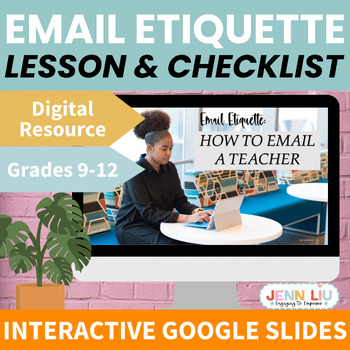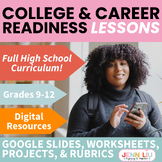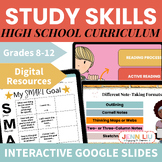Email Etiquette/Writing an Email to a Teacher - High School Study Skills Lesson
- PDF
- Google Apps™

What educators are saying
Also included in
- Attention all high school educators counseling or teaching in an AVID, Advisory, life skills, or other college and career readiness programs! If you're feeling a little lost or stressed coming up with lessons and activities for your college and career readiness curriculum, I got you!Save yourself prPrice $217.80Original Price $272.25Save $54.45
- Looking for engaging lessons to ensure your high school students are equipped with the most essential college-readiness study skills?Get this eight-week bundle of NO-PREP interactive Google Slides presentations and rest assured your students will be successful during and after high school! ⭐️ WHAT'SPrice $44.60Original Price $55.75Save $11.15
Description
Are you tired of seeing poorly written email messages from your students? Teach your middle or high school students proper email etiquette and how to write an email to a teacher with this interactive Google Slides lesson!
⭐️ This complete lesson includes an explanation of email etiquette and its importance, parts of an email, how to write an email, dos and don'ts, a practice activity, and an interactive email checklist!
⭐️ With the increase in distance and online learning, this lesson is more necessary than ever!
⭐️ This resource is a COMPLETE LESSON in one place (similar to a Hyperdoc, which takes students through the learning cycle in one doc or slide deck using hyperlinks and other media). Perfect for using as a differentiated, self-paced, student-centered lesson and/or whole class presentation!
⭐️ This interactive Google Slides presentation can be used with face-to-face instruction, distance learning, OR a blended, hybrid, or flipped learning approach in an English language arts, AVID, advisory, or any other class. Counselors can also use this to give a study skills presentation to a large audience or help students one-on-one or in small groups.
⭐️ WHAT'S INCLUDED (a full 5E lesson that takes students through the entire learning cycle!):
- Engage: Questions to hook students and activate prior knowledge at the beginning of the presentation.
- Explore: Question to activate prior knowledge.
- Explain: Explicit instruction with an explanation of email etiquette and a complete breakdown of how to write a proper email message.
- Elaborate/Extend: Practice activity with an interactive email checklist!
- Evaluate: Overall lesson reflection questions at the end of the presentation.
⭐️ The entire lesson should take about one hour or one class period. Please be sure to read the “Suggestions for Use” below!
⭐️ This lesson has it all:
- Explicit instruction: This lesson is direct and systematically chunked following a 5E lesson plan and guides students with a clear purpose/essential question, explanation, and supported practice/extension.
- 21st century skills: Students use media and technology literacy skills with this interactive Google Slides presentation and use critical thinking, collaboration, and communication with all the opportunities for discussion.
- Multi-modalities and hands-on learning: Students view and/or listen to the presentation, write and talk about their learning in “think-write-pair-shares” and discussion groups, and possibly more depending on what you assign in the extension, such as producing an essay or video to demonstrate understanding and synthesizing ideas.
- Differentiation: Depending on students’ levels, you could present to the class as a whole and/or assign students to view the slides independently or in small groups and answer the questions as you see fit.
- Scaffolding: This complete lesson comes in manageable parts, from activating prior knowledge to reflection and assessment, and can be teacher- or student-paced.
- Higher levels of questioning: The discussion questions require higher-level thinking such as analysis, evaluation, and synthesis.
- Real-life connection: The college and career-readiness topic and essential question are meaningful and relevant to students’ futures.
- Student choice: To add student choice, give students options of strategies, tools, and/or extension activities.
⭐️ You might also like this Study Skills BUNDLE, which includes this lesson!
SUGGESTIONS FOR USE:
1. Present the slides in a face-to-face lecture OR through a video conference lecture by sharing your screen. To make your presentation more interactive and engaging (and less of a teacher-centered lecture), be sure to have students answer the questions and share their answers at the beginning and end of the presentation (see ideas for sharing below), stop to check comprehension, use peer teaching, and clarify or explain anything as needed.
2. OR, you can just send the slides to your students by email or Google Classroom to work on independently or in small groups and type their answers on the slides (not necessary to insert text boxes), a Google Form, or a separate document -- whichever you prefer (make sure you make a copy for each student).
3. Do some kind of combination of #1 and 2. You may also want to work one-on-one with some students and let others work independently.
4. Follow the lesson plan and extra ideas given in the product directions.
LESSON PLAN:
This presentation is really a complete lesson all in one place and includes all the elements any good lesson should have: an essential question, a hook, activation of prior knowledge, direct instruction (teach/learn), extension, reflection, and assessment (AKA "the 5E Instructional Model"). Here is the breakdown:
1. Essential Question: The lesson starts with an important EQ, which lets students know up front the purpose and driving question of the lesson. Start by discussing this EQ with students.
2. Hook: Hook, or "engage" your students with the quote given at the beginning of the presentation and allow them to “think-write-pair-share” about it either in person (you could pass out Post-its for writing answers to put up on the board), in an on-line chat if you are presenting in a video conference, or you may add a link to where you want them to post their responses (e.g., Padlet, a Google Form, or a shared Google Doc), and/or you can just have students type their responses on the slides and submit their slide deck to you after they get through all the slides.
3. Activate Prior Knowledge: Have students "explore" the topic by answering the given question with another “think-write-pair/group-share.”
4. Learn/Direct Instruction: This is when you "explain" the lesson, but how you approach this will again depend on your students and how much scaffolding and differentiation is necessary; you can present to the whole class (face-to-face or in a video conference) or give the slide show out for independent work or flipped learning, making your class more student-centered and hands-on and allowing advanced students to go at a faster pace and move on to extension lessons you assign.
5. Extend: This part of the lesson requires students to check their understanding and then "elaborate" on or apply what they learned beyond the information presented by writing a practice email to one of their teachers and then checking it with the checklist. You can also have students share their practice emails with a partner and give each other feedback.
6. Reflect and Assess: This is like an exit pass. Questions are provided at the end of the slide show to allow students to reflect on what they learned and provide you a tool to collect feedback/data to inform your instruction.
IF YOU LIKE THIS PRODUCT AFTER PURCHASING IT, PLEASE GO TO YOUR TPT PURCHASES AND LEAVE ME A REVIEW AND EARN TPT CREDITS! AND BE SURE TO FOLLOW ME ON TPT FOR UPDATES ON NEW PRODUCTS!
CREDITS: Grade Onederful, Kaitlynn Albanni, Lemony Fizz, Speaking of Images
⭐️ Get this FREE College and Career Readiness Curriculum Planning Guide on my website! Click HERE.
⭐️ Get in touch by using this form HERE.
⭐️ Check out my other products on TPT and find out when I make new products (be sure to follow!): Jenn Liu: Engaging to Empower
Aloha,
Jenn
Copyright © Jenn Liu
Permission to use for single classroom use only.
Please purchase additional licenses if you plan to share this product with other teachers.







